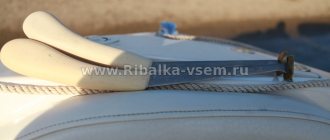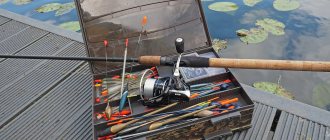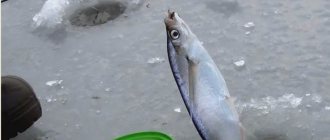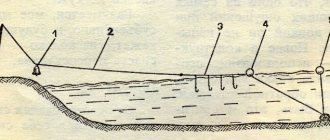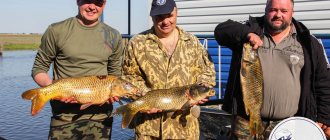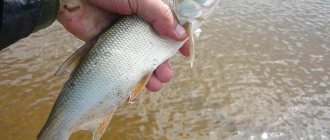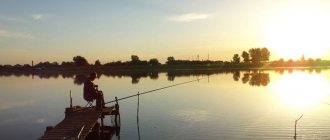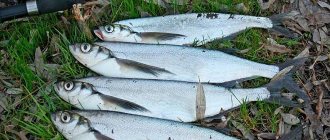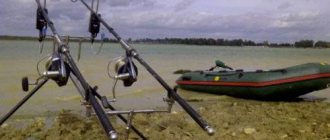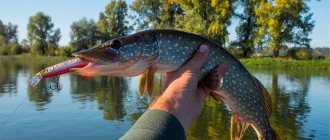Fishing for sabrefish is of considerable interest to both beginners and experienced fishermen. And this is quite understandable - the fish has excellent taste. And the process of catching it itself is an exciting, purely sporting activity. True, finding and catching this individual is actually not so easy, although it is found in large quantities in many rivers, large lakes and reservoirs. The reason for the “intractability” lies in the behavioral characteristics and habits of this fish. Therefore, before you figure out how to catch saberfish, you should get to know it better. So
About fish
Chekhon is one of the brightest representatives of schooling fish belonging to the carp family. It is very difficult to confuse it with other inhabitants of the underwater world. The elongated body, flat on the sides, and shiny small scales make this fish very similar to the stub of a saber. It is often called that, and also called saber, Czech, bokovnya.
An adult specimen can reach a length of up to 60 cm. The maximum weight of individual specimens is 1 kg, although, as a rule, fish weighing from 200 to 500 g are caught on a hook. A Czech fish that has escaped such a fate can live 10–12 years.

Czech habitats
This fish is found in large rivers that flow into the Black, Azov, Caspian and Baltic seas. There is especially a lot of it in the waters of the Volga-Akhtuba floodplain and the Trekhrechye region.
The Czech fish prefers depth and rapid currents, so it practically does not enter small bodies of water, especially if the bottom is completely covered with algae. During daylight hours, fish move across all horizons and often find themselves at the very edge of the water to hunt for fry or drowning insects. But the saber still does not approach the shore. By nightfall it completely sinks into the depths and only in the morning begins to rise again.
At the end of spring and summer, a school of fish constantly migrates along the river, but does not move far from the once chosen area. In winter, the habitat of the saberfish becomes deep depressions with a slight current, where it tries to stay a meter from the bottom.

Description of saberfish as a species
The sabrefish (lat. Pelecus cultratus), a fish of the carp family, has a very unusual body shape - it is highly flattened and resembles a curved saber. For this, it is sometimes called a “saber” and a “cleaver.” The scales of this fish have a bright silver color, the mouth is small and strongly turned up, which is explained by the peculiarities of the diet. Adult saberfish are predators. They live in large flocks, but are very careful and shy.
In our country, saberfish live mainly in the south; there is a lot of it in the Caspian and Black Sea basins. It prefers large bodies of water and can stay at depths of up to 30 m. On the Lower Volga, including Akhtuba, there are residential (never leaving the river beds) and semi-anadromous (entering the riverbeds from the Caspian) forms of sabrefish.
On Akhtuba, saberfish usually reach a length of up to 40 cm and a weight of up to 0.5 kg, but there have been cases of catching individuals weighing up to 1 kg. The minimum permitted size of sabrefish caught in the Astrakhan region according to fishing rules is 22 cm.
Chekhon spawns from April to June, during the period of high water and at a water temperature of at least +10 °C. At the same time, the residential form of sabrefish spawns in shallow waters, laying eggs on aquatic plants, and the semi-anadromous form - directly in the stream on the surface of the water (its eggs are carried by the current to the Delta).
Another feature of sabrefish is its very active, mobile lifestyle, characteristic of most pelagic fish. She does not like standing water, overgrown ponds and muddy shallows. She needs space, depth and streams of clean water, rich in food. The main diet of sabrefish consists of insects and larvae, worms and fish fry.
Chekhon habitats
This fish, even more cautious than the asp, never comes close to the shore during the day, and at night goes to the depths and into channel holes. But during periods when there is a lot of food (insects, larvae) on the surface of the water, saberfish can walk in the surface layer almost around the clock. As the water gets colder and there are night frosts, you need to look for sabrefish at the very bottom - its food sinks there.
Chekhon is a schooling fish; the number of individuals in a school can vary greatly: from several tens to hundreds of specimens. Small flocks of sabrefish “graze” in creeks and small pools, while large flocks prefer rapids and riverbeds. On the water, saberfish reveal themselves with small splashes, which are especially noticeable early in the morning or late in the evening.
Frightened by a strange sound, a school of saberfish immediately goes into the depths and can return to its original place only after a few hours, and sometimes the next day. Schools of sabrefish are often accompanied by asp, which stays a little deeper, hunting both the fry that is being scared away and the sabrefish itself. The minimum distance at which you can bring a boat to a flock of sabrefish usually does not exceed 30 meters, while you must maintain silence, but there is no need to worry about camouflage - it has been noted that sabrefish do not react to bright colors.
Read also: Successful crucian carp fishing in winter
Best time to catch sabrefish
This is one of the most exciting periods of fishing. Having spawned in May-June, the sabrefish gets sick for a short time, sliding down to its permanent habitat, and then its appetite suddenly awakens: too much effort has been spent on crossings and fighting the strong current. At this time, she selects areas where channel depths are adjacent to extensive shallows and the boundary between fast and slower currents is marked. Chekhon likes to stand over shallow sand spits, islands and terraces, waiting for the rapid flow to carry some insect that has fallen into the water into a calmer area.
Like most cyprinids, the sabrefish bite becomes more active when the upper dam opens. At this time, almost all the fish on the river go to the stream, as the water level rises and it washes away living creatures from the shore. During such periods you will often see saberfish hitting every little thing that floats with the flow.
What does a Czech eat?
Like all carp, this fish feeds all year round, with the exception of the spawning season. Her main diet consists of:
- zoo- and phytoplankton;
- various types of worms;
- insects and their larvae;
- small molluscs and crustaceans.
From the age of 3, the Czech cat’s “predilections” change; she becomes a predator and begins to hunt small fish. The saber feeds around the clock, but is most active in the morning and evening hours.

When is the best time to catch
The moment of highest activity of sabrefish on Akhtuba is considered to be the period preceding spawning. The fish feeding begins around the second half of April and can last up to 3 weeks. This is the time to go fishing – saberfish will bite on anything! In an effort to gain strength before spawning, she greedily pounces on the offered bait. And if the angler manages to catch the movement of the school, then in a short time it will be possible to catch a dozen excellent specimens.
Something to remember! During spawning, the bite stops completely and begins again only a few weeks after spawning, when the fish return to their favorite places.
In general, saber can be caught from early spring until the river is covered with ice. In summer, it bites better in the morning, evening and at night. With the arrival of autumn, Czech fish begin to be caught closer to lunch, when the daytime temperature reaches its maximum value. In winter, the saberfish does not show much activity, although some fishermen continue to hunt for it, regardless of the season, and at the same time very successfully.
Tackle, bait and methods of catching sabrefish in Three Rivers
Considering the rather large size of the water areas of the Trekhrechye rivers and the strong current, the conditions for catching saberfish in these places are ideal, especially if you have a boat with a motor. It is possible to purposefully catch this fish from the shore; the fisherman's capabilities will be limited, since fishing for sabrefish will take place at a great distance from the shore and with frequent movements from place to place, which may be associated with certain difficulties due to the complex topography of the coast. A leash is not used when fishing for sabrefish, and the risk of “catching” a pike when fishing on the surface in the riverbed is minimal. To catch sabrefish on Akhtuba, depending on the season and fishing conditions, the following gear is usually used:
- a spinning rod with artificial bait in the form of a small oscillating or rotating spoon with a weighted core, since a small bait will have to be cast quite far;
- a spinning rod with a Sbirulino (bombard) rig, where the role of a load for long-distance casting is played by a heavy but floating or slowly sinking streamlined float, to which a small spoon, streamer or even a fly is attached on a sliding leash (in-line). This method is especially effective when catching sabrefish during the period when insects emerge, when the silver-white predator purposefully hunts on the very surface of the water;
- a spinning rod with a very small floating or sinking wobbler or popper;
- fly fishing with a special rod with a conical cord using flies and streamers is also very effective, but is rarely used by fishermen due to the high cost of gear and the need for special skills;
- wire and blind fishing rods with bait or live bait are often used for catching sabrefish, especially during the season, and sometimes, in the skillful hands of an experienced fisherman, they can give a head start to many other gear. Again, it is worth paying attention to the horizon for catching sabrefish - first of all, this is the surface and upper horizon of the water, but in some cases, which we will talk about later, you can catch sabrefish from the bottom;
- Bottom gear is rarely used for catching sabrefish, they are too rough and it is possible to catch such fish only in very rare cases.
The saberfish has very weak lips, which, when hooked or roughly fished, are easily torn off if the tackle is rough. Therefore, special requirements are imposed on spinning equipment for catching saberfish. You can consider, for example, the following gear options for catching sabrefish from a boat:
Option 1
Light class spinning rod with fast or medium fast action, 2.40 – 3.20 meters long. It should be quite sensitive and have a test of 0-12 or 4-15 grams approximately - you will have to work with very light baits. You will need fast reels, class 2000-3000 Shimano or 1500-2500 Daiwa, with a large supply of line. The main line should be thin enough, for example, monofilament 0.16-0.20 mm or braided cord 0.10-0.14 mm. Such equipment will work successfully when catching sabrefish from a boat using small spoons and wobblers of an elongated, slanted shape. For example, Mepps spinners numbers from “0” to “2” or Kastmaster spinners with a length of 2.5-3.5 cm.
Option 2
A spinning rod for catching sabrefish using Sbirulino tackle should be much more biting and long. We choose a spinning rod with a length of 3.2-3.6 meters of medium action, since when casting you will have to manipulate a rather heavy bombard float with a leash 1.2-1.5 meters long. There are special rods for sale for Sbirulino, but you can limit yourself to a more universal one of sufficient length. In this case, the coil may be less fast, but still quite spacious. The main line is slightly thicker than in the previous version - ideally: braid 0.13-0.18 mm in diameter. Bombarda (Sbirulino) is selected floating or slowly sinking, colorless (transparent) with a leash made of monofilament or fluorocarbon. Lures: flies, streamers, small wobblers, the smallest spinners and oscillating spoons, insects (horseflies, dragonflies, grasshoppers, etc.) attached to a hook without weight. This type of gear can be fished both from the shore and from a boat, since the bombard allows you to make very long casts of light bait.
Option 3
Fishing rod for catching sabrefish. On Akhtuba and Mangut, when fishing for sabrefish, in some cases you can effectively work with a wire or blind (Bolognese) fishing rod. A huge advantage of such equipment is its high maneuverability, sensitivity and feeding speed of the nozzle. The disadvantages include a small radius of action, and given that the saber fish tries to stay away from the shore and is very shy, such tackle is rarely used. Nevertheless, you can use a rod with guide rings up to 5 meters long under a wire tackle with a self-loading float for catching sabrefish on insects and bait fish, or a blind rig on a rod up to 7-9 meters long, since you will have to fish from a depth of 3-4 meters in the backwaters where saber fish come up in the summer in the first half of the night.
The same insects, larvae, worms and maggots can be used as bait. In the dark, you can use a float equipped with a chemical light source (“firefly”), which can now be easily purchased at a fishing store.
Saber Spawning
A Czech can reproduce offspring after reaching sexual maturity, which occurs in the 2nd–4th year of its life (depending on living conditions). In most reservoirs, spawning occurs at the same time, when the water warms up to a temperature of 12 °C. In central Russia, sabrefish spawning begins in May or June. However, due to weather, these dates may shift in one direction or another.
The spawning period begins with the rise of fish to the upper reaches of the river. This is where she will spawn. Individuals living in reservoirs and lakes prefer to do this near the mouths of rivers and streams, where the oxygen content in the water will be slightly higher. The depth of the reservoir in spawning areas can reach 6 meters. The spawning process is very rapid and takes from 7 to 10 days.

Finding a place for effective fishing
Finding sites of sabrefish is often very difficult. Moreover, these places may change at different times of the year. Even knowing for sure where sabrefish live, the fisherman has to take into account that in spring and autumn this individual makes mass movements. At this time, it can be found near holes, in shallows, on elevated bottoms, near bushes or flooded tree trunks. After spawning, the saber returns to its former habitats. Where can you catch saberfish at this time? Experienced fishermen advise looking for it:
- close to deep holes;
- on the border of currents;
- in places of rifts and sand spits;
- in large bays that are not overgrown with algae;
- in deep-sea creeks.
The saberfish is caught mainly in the upper and middle layers of water. However, this does not mean at all that it cannot be caught using bottom or other gear intended for other types of river inhabitants. The Czech woman is very curious, she is interested in any object that has fallen into the water. Sometimes she manages to grab the bait before it reaches the bottom. Professionals know: if a bite occurs, there is no need to leave this area; here you can count on a very effective catch.
See also:
- Bream fishing in spring
- How to tie fishing knots
- How to properly arrange goose decoys when hunting
The Czech fish does not like to approach the shore, so long casts are required to catch it. There is no point in hunting for saber fish at night: it hides or sinks to depth.
Attention! You can detect where this type of fish gathers by looking at the seagulls circling above the water. There will be no strong splashes in such an area; only light ripples are possible.

Fishing with fry (live bait)
Closer to autumn, sabrefish are increasingly being caught in fishing for fry. It is best to take juvenile bleak or verkhovka for bait. The fishing rod is not much different from the one used for fishing using insects, except that it is better to take a larger hook - No. 4-6, with a long shank. Once I happened to come across a school of sabrefish, which was hitting a bleak near a sandy snag on the edge of a sand spit, after which there was a cliff to a depth of 2.5 m. The sabrefish took it immediately as soon as the float was near the catchable place. Nearby, in a similar area, a small pike perch was hitting. This proximity of different predators was somewhat surprising, but then they told me that others had observed a similar phenomenon and, together with sabrefish, caught chub, perch and other fish. On the Volga, saberfish are often caught mixed with asp. These fish are very similar in their structure and habits; they both have an upper mouth and, when setting up penal raids for bleak, they grab it from below.
Usually the flocks are located like this: closer to the shore there is a school of saberfish, and further away there is a “herd” of asp. Sometimes it seems that schools of different predatory fish work in tandem, helping each other... But it is not at all uncommon for fattening schools of sabrefish to not reveal themselves at all, hunting in the lower layers of water. That is why you need to know well the bottom topography over which they can stay. My friends managed to discover one of these places on a bend of the Oka near Kasimov, where there were transverse underwater terraces - sort of shafts 40-50 cm high and up to 10-15 m long. And there, above the crests of some terraces, there are small ones, about 10 -15 individuals, flocks of sabrefish, and nearby, by the way, small flocks of asps occupy similar places.
Fishing Features
You can go Czech all year round. But since its activity directly depends on the season, fishing will have its own characteristics.
Winter
Winter fishing for saber fish is a rather difficult process, but very interesting, since not everyone is able to get the desired prey at this time of year. The problem is that with the onset of cold weather, the Czech fish goes into the pits, where it remains until the beginning of spring. At this time, she is very sedentary and does not have a special appetite. To find it, you will have to try hard and examine more than one section of the reservoir. The most promising in this regard are the turns of the river bed, where there are holes and changes in depth, as well as places where the current borders on standing water.
The main equipment at this time of year is the so-called sabrefish garland, which is very easy to install yourself. At its core, it consists of several short leashes with jigs or hooks tied to the main fishing line.
The equipment is attached to a regular fishing rod, which is used by jig fishermen. Both a classic balalaika and a fishing rod with a foam handle are suitable for this purpose. As bait, you can use dung worms, maggots, bloodworms, dough, lard, artificial baits - individually, or better in the form of a sandwich.
There is no special technique for this method of catching sabrefish from ice. The tackle is lowered into the hole, and the angler waits for a bite. If necessary, the saber can be lured by playing, making soft nods with a slight amplitude.
There is nothing complicated in the process; knowing at least in general terms how to catch saberfish in winter, you can easily count on an excellent catch. The main thing is to guess the location of the hole.

Spring
Spring is the best time when saberfish begin to bite. During this period, the fish reacts very violently to any bait, so you can catch it with a variety of gear: elastic, mast rod, spinning rod, feeder, bombard. The reason for this activity is the spawning run, during which Czech fish can be caught in huge quantities and without much effort. Unfortunately, this crazy bite will not last long, no more than 2-3 weeks, then it fades away and the saberfish begins to take a break.

Summer
In summer, fish are caught mainly in those regions where the heat has not yet reached. Moreover, it bites most actively on rainy or cloudy days. The best places to catch saberfish at this time are sand spits and areas located along thickets of vegetation. If you manage to find the boundary between the currents, you can count on a good trophy.
The most suitable gear at this time of year would be a rubber band and a fishing rod for live fishing. You can use worms and grasshoppers as bait.

Autumn
In autumn, this individual prefers to hunt in the water column; sometimes it can feed at the very bottom. They catch it in September, October and early November. If it is not necessary to feed saberfish in spring and summer, then in the fall you should not refuse bait. It is best to fish on a feeder. As a bait you can use maggots, worms, and at a later time - bloodworms.
In the fall, the Czech fish bites sharply, but not as wildly as in the spring, so when catching it during this period, it is very important to feel the bite in time.

Catching sabrefish on a feeder
Fishing with bottom gear, which is a feeder, requires more attention to preparing bait for the feeder than paying attention to the casting range and accuracy. To prepare aromatic complementary foods, you can combine boiled wheat or millet, corn flour, hemp grains, bran, and mixed feed with a small addition of water. It is advisable to add a little chopped dung worm or bloodworm to the composition as an odor enhancer. The result should be a thick and sticky mass that is “driven” into the feeder.
Making feeder equipment is a responsible matter and requires some skill. The tackle is organized from many components. Read about how to make feeder equipment with your own hands in a special guide, which also describes the fishing process.
The video shows how the feeder gear for catching sabrefish is organized. Let's take a look and get to know each other...
Feeder tackle requires the presence of 2-3 thin leashes with attached hooks No. 6-8. As bait, you should use maggots, bloodworms, worms or bait of plant origin (corn, wheat). If the fish does not want to take the bait from the bottom, you should put a foam ball on the shank of the hook, which lifts the bait into the water column.
In rare cases, when the fish does not want to bite at all, it is necessary to place more bait around the tackle so that the smell spreads over a long distance. To do this, bait balls are rolled by hand and thrown into the water near the feeder.
Baits and lures
Saber fish are quite omnivorous, but their main preference is for bait of animal origin. You can catch it on:
- dung worms;
- maggots;
- bloodworm;
- grasshoppers;
- flies;
- butterflies;
- dragonflies;
- os.
This individual is especially partial to maggots. This bait is the best of all that is used to catch saberfish. As a rule, from 2 to 5 fly larvae are attached to one hook. It is best if they are of different colors, for example, white and red. A combination of maggot and bloodworms also gives a good result.
Experienced fishermen often add a foam ball to the bait. This design will be most appropriate if the bottom of the reservoir is muddy and the nozzle can easily get lost.
In addition to maggots, in spring you can use other baits - dung worms, caddis flies, bloodworms. In summer, during the season of mass appearance of insects, fish can be caught on them.
Large individuals bite well on fry, but you need to choose small live bait. Artificial baits for fishing will also come in handy in this case.

Groundbait and its components
You can catch saber without bait. However, for sabrefish fishing to be truly effective, it is better to use all available methods.
Feeding should be done in small portions, because the main goal of the fisherman is to keep the flock without saturating it. You should not use only sunflower cake or porridge for this purpose: in this case, only one small thing will fall on the hook. As a basis for bait, you can choose any basic compositions available in stores. When preparing the mixture, it is necessary to add to it the bait on which fishing is carried out, and what the saber fish bites best on - chopped worms or maggots.
Throwing bait in bulk is useless: the current will wash it away in a couple of minutes. As a container for the mixture, you can use a special jar made of perforated sheets, a mesh bag, or an old nylon stocking.
Elastic band and fly fishing
They also catch sabrefish using such a common and cheap tackle as an elastic band. Its advantages are obvious - in order to change the bait or reel in a caught fish, there is no need to completely pull out the equipment along with the sinker, and then scare the fish by re-casting. The piece of rubber used in this tackle allows you to check what is happening on the hooks without making unnecessary noise.
Until October, it is quite possible to catch saberfish by fly fishing. This method of fishing, still exotic for the countries of the former USSR, involves the use of surface baits resembling various insects, as well as special fishing methods. Asp and chub are also often found in bycatch, but fly fishing has not become widespread.
Tactics and fishing techniques
The success of fishing directly depends on the correct choice of gear. Equally important are the ability to use it, the technique and tactics of fishing, which have to be chosen in each specific case.
To the feeder
Once a fishing spot has been chosen, you can proceed to feeding it. To do this, you should make 5–10 casts without a leash, with one feeder filled with a mixture prepared in advance. To attract fish faster, you can take a slightly larger container. After several casts, the feeder should be changed and a leash with a hook and bait should be added to it. Its length can be up to 2 meters - and this is the main feature of the feeder. Of course, throwing such a tackle onto a sabrefish will be somewhat more difficult, but the result of the efforts will not be long in coming.
When fishing with traditional baits, the bite can occur almost instantly as the bait slowly moves towards the bottom on a long leader. However, fishermen came up with the idea of putting a foam ball on the hook, which allows the maggot or worm to remain in half-water all the time. This kind of gear is truly killer! It allows you to catch sabre, without being distracted by other species, for example, silver bream or roach. But the main advantage is the ability to use feeder equipment for catching sabrefish in the current, and the video below very eloquently confirms this.
The consistency of the bait should be chosen so that it stays in the feeder for no more than 5 minutes. After this time, the tackle must be checked. If there are no bites for a very long time, most likely the fishing place was chosen poorly.
On the float
Taking into account the peculiarities of the behavior of the Czech fish, it is better to catch her in the retrieve. In this case, the tackle must be cast and released with the flow. The reel arc should be folded back so that the line can be released freely. But you need to keep your finger ready so that when you bite, you can instantly clamp the monofilament and make a hook.
In traditional float fishing, the bait must be constantly in motion. Otherwise, the saber simply may not respond to the bait.
For spinning
When fishing with a spinning rod, experienced fishermen advise using stepped fishing. You can perform it immediately after the bait touches the bottom. There is no need to make any additional movements with the rod; wiring is carried out only by rotating the reel.
Lures made of edible rubber are ideal as bait, although Czech fish are also excellently caught using a wobbler or twister.
Recently, ultralight spinning rods have been of particular interest to anglers. Despite their apparent fragility, they can withstand quite heavy loads, so they allow you to catch a saber without any effort.

To the bombard
This is one of the new methods of spinning equipment for sabrefish, invented in Italy. Bombarda, or sbirulino, is a kind of heavy float that serves as a sinker for long casts.
Despite the apparent intricacy, this tackle is quite simple; its installation on a saber cap can be done in a short period of time. There may be several assembly methods. The most common is the classic version. To carry out such installation, you must:
- wind the main line onto the fishing rod reel;
- put a bombard on it and secure it with a rubber shock absorber;
- tie a swivel to the end of the main line;
- attach a leash with bait to his ear.
In this case, the bombard will be located above the bait. In other installation options, it can be attached to the very end of the main fishing line, and the leash – above it.
After the bombard is assembled, you can move on to choosing flies for catching saberfish. Since the favorite delicacy of an adult saber is fry and insects floating on the water, the baits should look accordingly. To achieve better results, you can hang several flies at the same time.
Fishing with this type of gear is very easy. The wiring in this case will consist of a series of leisurely pull-ups that will help imitate the movements of an insect that has fallen into the water and is trying to take off.

Catching fish from the bottom
This method of catching sabrefish is practiced in cases when schools of fish go to depth, for example, in the evening or during the summer cold spell. A fishing rod with a blind rig is quite suitable for this purpose. The length of the rod should be at least 6–8 meters. The shipment is selected depending on the flow speed: in a fast flow it can consist of several groups of small sinkers, in a slow flow it can consist of pellets decreasing downwards.
As a nozzle for bottom wiring, a dung worm, a bunch of maggots, or the larvae of some insect living in the water are used. You should not refuse bait either.

Fishing with an elastic band
Before spawning, Czech fish can be caught using almost any tackle that has a hook. But it is best caught on a donkey with a rubber shock absorber, popularly called an “elastic band.” Its main advantage is its simplicity and ease of use. The “elastic band” allows you to reel in your catch and change bait without pulling the main gear out of the water. You just have to transport it to the right place using a boat. Although, with some skill, the rubber band can easily be thrown from the shore.
After delivering the tackle to its place, you need to tighten it a little so that the fishing line is in constant tension, and secure it to a peg. In order to notice the bite in time, you can hang a bell on the monofilament. The bait is placed in several pieces, depending on the size of the hook on the sabrefish.
To attract the attention of the fish, the line should be twitched periodically. When biting, it is necessary to hook. To do this, you need to pull the elastic band towards you with a sharp movement, then release it and only then smoothly pull it to the shore.
We can talk about what to catch and how to catch saberfish for a very long time. The main thing that a beginner must understand is that there is nothing complicated in this process. It is enough to follow the simplest recommendations of experienced fishermen - and the coveted trophy will not take long to arrive!
Catching sabrefish with bottom tackle
In summer, simultaneously with sunset, saberfish leave the upper layers and rush closer to the bottom, where they continue to feed. You can successfully catch sabrefish even in the coastal zone, but provided that the depth at the selected point exceeds two meters. For fishing, an 8-meter match rod is used, which is equipped with a luminous float.
The load is selected based on the strength of the current. In order to maintain the sensitivity of the tackle, several small pellets are installed on the fishing line with an interval of 25 cm between them. The bites of sabrefish in the dark continue until approximately 12 o'clock at night, after which there is a lull. Fish activity resumes before flowering. You can catch sabrefish from the bottom during the day, but only if the weather is cloudy and the daily air temperature drops.
Dung worms, maggots, and aquatic insect larvae are used as bait. It is always possible to attract sabrefish to the fishing site by using bait, the main composition of which necessarily includes a small part of the bait used.
An excellent option for feeding a place is to use clay, into which scalded maggot or chopped worm is mixed. Balls are made from the resulting mixture and lowered into the water a few meters from the fishing point. Gradually, the clay balls will be eroded by the current, due to which pieces of food will fall out of them. The smell of a chopped worm can attract saberfish from any corner of the pond.
